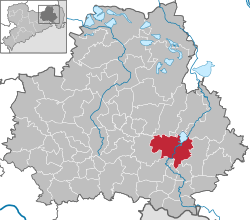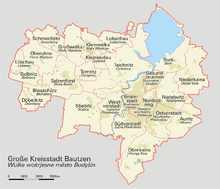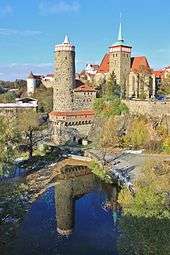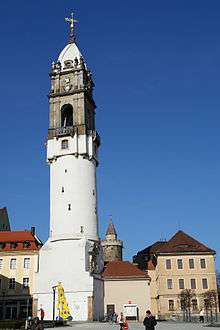Bautzen
| Bautzen/Budyšin | ||
|---|---|---|
|
| ||
| ||
 Bautzen/Budyšin | ||
Location of Bautzen/Budyšin within Bautzen district  | ||
| Coordinates: 51°10′53″N 14°25′27″E / 51.18139°N 14.42417°ECoordinates: 51°10′53″N 14°25′27″E / 51.18139°N 14.42417°E | ||
| Country | Germany | |
| State | Saxony | |
| District | Bautzen | |
| Government | ||
| • Mayor | Alexander Ahrens (none) | |
| Area | ||
| • Total | 66.62 km2 (25.72 sq mi) | |
| Population (2015-12-31)[1] | ||
| • Total | 39,845 | |
| • Density | 600/km2 (1,500/sq mi) | |
| Time zone | CET/CEST (UTC+1/+2) | |
| Postal codes | 02625 | |
| Dialling codes | 03591 | |
| Vehicle registration | BZ, BIW, HY, KM | |
| Website | www.bautzen.de | |
Bautzen (pronounced [ˈbaʊ̯t͡sən]; Upper Sorbian: Budyšin [ˈbudɨʃin]; Lower Sorbian: Budyšyn [ˈbudɨʃɨn], Czech: Budyšín [ˈbudɪʃiːn], Polish: Budziszyn [buˈd͡ʑiʂɨn]) is a hill-top town in eastern Saxony, Germany, and administrative centre of the eponymous district. It is located on the Spree River. As of 2013, its population is 39,607. Asteroid 11580 Bautzen is named in honour of the city.
Bautzen is often regarded as the unofficial, but historical capital of Upper Lusatia, and it is the most important cultural centre of the Sorbs, a Slavic people.
Geography
Geographical situation
The town on the River Spree is situated about 50 km (31 mi) east of Dresden between the Lusatian highland and the lowlands in the north, amidst the region of Upper Lusatia. To the north stretches the Bautzen Reservoir, which was flooded in 1974. This is the former location of the villages of Malsitz (Małšecy) and Nimschütz (Hněwsecy).
Expansion of the urban area
The old part of Bautzen is located on the plateau above the Spree, whose top is marked by the Ortenburg castle. It is bordered by the city walls. The later-built more recent quarters in the east were enclosed by the city ramparts. After their removal, the city expanded further east and to the left bank of the river. However, there has only been a small urban area west of the Spree until today. In the 1970s, the development areas of "Gesundbrunnen" and "Allendeviertel" were erected. After 1990, several neighbouring villages were incorporated.
Bordering municipalities
The city is bordered by Radibor, Großdubrau and Malschwitz in the North, Kubschütz in the East, Großpostwitz, Obergurig and Doberschau-Gaußig in the South, as well as Göda in the West. All of these belong to the Bautzen district.

Subdivisions
The 15 city districts are (inhabitants as of 1 January 2009):
- Innenstadt (Nutřkowne město - "City centre"), 5'278 inh.
- Südvorstadt (Južne Předměsto - "Southern outskirts"), 1'738 inh.
- Westvorstadt (Zapadne Předměsto - "Western outskirts"), 3'505 inh.
- Gesundbrunnen (Strowotna studnja), 8'178 inh.
- Nordostring (Sewjerowuchodny Wobkruh - "North-eastern ring"), 10'727 inh.
- Ostvorstadt (Wuchodne Předměsto - "Eastern outskirts"), 6'360 inh.
- Teichnitz (Ćichońca), 377 inh.
- Nadelwitz (Nadźankecy), 268 inh.
- Burk (Bórk), 325 inh.
- Oberkaina (Hornja Kina), 832 inh.
- Niederkaina (Delnja Kina), 522 inh.
- Stiebitz (Sćijecy), 510 inh.
- Kleinwelka (Mały Wjelkow), 1'314 inh.
- Salzenforst-Bolbritz (Słona Boršć-Bolborcy), 839 inh.
- Auritz (Wuricy), 458 inh.
History
Duchy of Poland 1002-1025
![]() Kingdom of Poland 1025–1032
Kingdom of Poland 1025–1032
![]() Margraviate of Meissen 1032-1253
Margraviate of Meissen 1032-1253
![]() Margraviate of Brandenburg 1253-1319
Margraviate of Brandenburg 1253-1319
![]() Kingdom of Bohemia 1319-1469
Kingdom of Bohemia 1319-1469
![]() Kingdom of Hungary 1469-1490
Kingdom of Hungary 1469-1490
![]() Kingdom of Bohemia 1490-1635
Kingdom of Bohemia 1490-1635
![]() Electorate of Saxony 1635-1807
Electorate of Saxony 1635-1807
![]() Kingdom of Saxony 1806-1871
Kingdom of Saxony 1806-1871
![]() German Empire 1871-1918
German Empire 1871-1918
![]() Weimar Republic 1918-1933
Weimar Republic 1918-1933
![]() Nazi Germany 1933-1945
Nazi Germany 1933-1945
![]() Allied-occupied Germany 1945-1949
Allied-occupied Germany 1945-1949
![]() East Germany 1949–1990
East Germany 1949–1990
![]() Germany 1990–present
Germany 1990–present
In the 3rd century AD an eastern Germanic settlement existed here, but excavations have proved that the region was already inhabited as early as the late Stone Age. Sorbs arrived in the area during the Migration period in the sixth century AD.
The first written evidence of the existence of the city was in 1002. In 1015 the Polish Army led by Bolesław I Chrobry defeated. In 1018 the Peace of Bautzen was signed between the German king Henry II and the Polish prince Boleslaus I. The Treaty left Bautzen (Budziszyn in modern Polish) under Polish rule. In 1032 the city passed to the Holy Roman Empire, in 1319 to Czech Crown lands and in 1635 to Saxony.
During the Middle Ages it was a member of the Six Cities' Alliance of the Upper Lusatian cities of Görlitz, Zittau, Löbau, Kamenz, Lauban and Bautzen.
It was the site of one of the battlefields of the Napoleonic War Battle of Bautzen in 1813.
In 1839 the Sorbian student organization Societas Slavica Budissenensis was founded in the city. The Sorbian House (Upper Sorbian: Serbski Dom), a Sorbian cultural centre, was opened in the city in 1904.
During World War II and the Nazi era, there was a subcamp of the Groß-Rosen concentration camp in Bautzen. Ernst Thälmann was imprisoned there before being deported to Buchenwald. Between 21 April and 30 April 1945, the Battle of Bautzen was fought.
Furthermore, Bautzen was infamous throughout the German Democratic Republic for its penitentiaries. Bautzen I was used as an official prison, soon to be nicknamed Gelbes Elend ("Yellow Misery"), whereas the secret Bautzen II was used as a prison for prisoners of conscience. Bautzen I is still used as a prison, and Bautzen II has served as a memorial since 1993.
In 2002 the city commemorated its 1000th birthday.
Main sights

Bautzen has a very compact and well-preserved medieval town centre with numerous churches and towers and a city wall on the steep embankment to the river Spree, with one of the oldest preserved waterworks in central Europe (built 1558).
Sites of interest include:
- The Reichenturm, one of the steepest leaning and still passable towers north of the Alps
- Ortenburg Castle
- The Old Waterworks, an architectural monument and museum
- Saint Peter's Cathedral, Eastern Germany's only historic interdenominational church edifice
- Hexenhaus (Witch's House), oldest preserved residential building (built in 1604)
There are four museums including the Stadtmuseum Bautzen ("Bautzen city Museum") and the Sorbisches Museum ("Sorbian Museum", Sorbian: Serbski muzej).

Sons and daughters of the town
- Karl Gustav Brescius (1824-1864), railway engineer
- Rudolf Buchheim, (1820-1879), German pharmacologist
- Wilhelm Buck (1869-1945), Prime Minister of the Free State of Saxony
- Friedrich August Carus (1770-1807), psychologist and philosopher
- Kurt Dinter (1868-1945), botanist and explorer in South West Africa
- Werner von Erdmannsdorff (1891-1945), General of Infantry in World War II
- Will Grohmann (1887-1968), art historian and art critic
- Erhard Heinz (born 1924), mathematician
- Hermann Hunger, (born 1942), Austrian assyriologist
- Hermann Lotze, (1817-1881), German philosopher and logician
- August Gottlieb Meißner (1753-1807), writer, founder of the German crime novel
- Harald Metzkes (born 1929), painter and graphic artist
- Ferdinand Neuling (1885-1960), General of Infantry in World War II
- Caspar Peucer, (1525-1602), German-Sorbian reformer, physician and scholar
- Charles Gottlieb Raue, (1820-1896), American homeopathic physician
- Georg-Hans Reinhardt (1887-1963), Colonel-General of the German Wehrmacht
- Simone Ritscher (born 1959), actress
- Friedrich Wilhelm Ehrenfried Rost (1768-1835), theologian and philosopher
- Hans von Tettau (1888-1956), Infantry General
- Hans Unger, (1872-1936), German painter
- Karl Friedrich Gottlob Wetzel (1779-1819), writer
- Handrij Zejler (1804-1872), born in the district Salzenforst, founder of modern Sorbian poetry
International relations
Bautzen is twinned with:
 Worms, since 1990
Worms, since 1990 Heidelberg, since 1991
Heidelberg, since 1991 Dreux, France, since 1992
Dreux, France, since 1992 Jablonec nad Nisou, Czech Republic, since 1993
Jablonec nad Nisou, Czech Republic, since 1993 Jelenia Góra, Poland, since 1993
Jelenia Góra, Poland, since 1993
References
External links
| Wikimedia Commons has media related to Bautzen. |
 Bautzen travel guide from Wikivoyage
Bautzen travel guide from Wikivoyage- Official website
- Interactive sightseeing tour through Bautzen (German)
 "Bautzen". New International Encyclopedia. 1905.
"Bautzen". New International Encyclopedia. 1905. "Bautzen". Encyclopedia Americana. 1920.
"Bautzen". Encyclopedia Americana. 1920.
